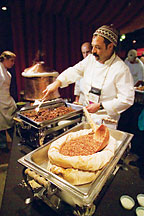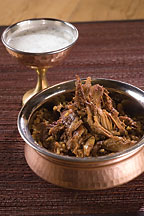
During the annual Worlds of Flavor International Conference and Festival held each fall at the Culinary Institute of America's Graystone Center in the beautiful Napa Valley, America's top food writers listen to the world's top chefs as they share their experience, insights and latest recipes. In the world of gourmet culinary trends, this is the event of the year. For chefs and foodies this is “The Super Bowl.” Who attends this world-class culinary super-event? More often than not, it is your competitors! It also draws celebrity chefs, top product developers, perceptive brand managers and internationally famous media stars.
Those in Attendance
Prepared Foods, through participation by this author, was present at this year's conference and several of its classroom sessions. Valuable experience was gained as many of the world's top restaurant chefs taught small, hands-on classes. The trendy innovations they shared may be tomorrow's fast casual fad or perhaps the next “Big Mac.” The teachers included celebrity chefs Rick Bayless of the Frontera Grill in Chicago; executive chef Wilo Benet of the Museum Restaurant Group in Puerto Rico; Sanjeev Kapoor of the world's longest running and most watched cooking show; Abhijit Saha, one of the world's top 10 Indian chefs; Harold McGee, best-selling author of On Food & Cooking; and Mai Pham, owner of Lemon Grass, one of America's hottest Viet-namese restaurants. Some of the best chefs from Spain, India, Thailand, Mexico and Turkey also attended and offered their culinary wisdom. New topics and techniques were discussed, explained and demonstrated, while the innovators who created them shared new recipes.
Reporting on Food Reporters
Robin Mather Jenkins is a staff reporter for the Chicago Tribune's Good Eating section. A journalist who writes about food, she uses the Worlds of Flavor to help her inform readers about what their favorite restaurants will be doing with food in coming months and what new flavor profiles they can expect to see in their supermarkets.“The Worlds of Flavors conference gave me some great insights into how contemporary American food is changing, and what a good thing that will be for all of us,” Jenkins notes. “The best news to come from the conference is that vivid, exciting food is on the horizon. It looks and smells great, it tastes superb, and it can even be good for you. As American food professionals explore traditional “foodways” from many cultures, we expect to join the fine cooks of other cultures at a common table,” she adds. In her opinion, “Everyone will eat better as a result.”
The New York Times' award-winning food writer R.W. Apple says, “What sets the annual Worlds of Flavor conferences apart from other similar food events is the considerable intelligence and detailed knowledge of the participants who come from all over the globe. This is no dine-around event with a thin overlay of scholarship. It's a place where genuine experts gather and generously share their experiences.” Alexandra Guarnaschelli, the executive chef of Butter, one of New York's hottest restaurants, also shares her impressions of Worlds of Flavors. “I expected it to be a place for me to interact with chef colleagues from all over the U.S. A few of those turned out to be this author's personal food heroes, Maricel Presilla, Rick Bayless and Paula Wolfert. I truly wasn't aware that we, as Americans, have such deep-seated flavor traditions! I came home feeling like the 'Worlds of Flavors' that merits investigation is in my own backyard. It's amazing how hard our food industry works to expose the public to the foods of the world.”
The sheer volume of trend information is staggering, and sorting the glitz from the hits is difficult. But based on the opinions and experience of the world's best, Caribbean cuisine may be ready to finally take off.
A Trend to Consider: Regional Caribbean
We have all heard it before: “Caribbean will be the next big thing!” However, for some reason, it never quite makes it. In the past, Caribbean product development seemed to go like this:1. R&D creates a great tropical-themed item. 2. Marketing team gets behind it. 3. The operations department manufactures it. 4. The company launches it. 5. Consumers ignore it.
Why have so many “Caribbean” products not done well? Perhaps it is because the product development teams have overlooked one huge piece of information; there are two types of Caribbean cuisine. Most consumers prefer one type or the other. Few like both.
Hispanic Caribbean Cuisine—Origins
Hispanic Caribbean is not easy to define or locate. Consider Cuba, Puerto Rico and the Dominican Republic. Each island is a mix of peoples and cultures. Latino culture and traditions are the primary social drivers, yet challenges face those who attempt to define and manufacture Hispanic Caribbean products.
In 1808, El Misisipi became the first Spanish language newspaper to arise from the U.S. Latino communities. This publication based its offices in what would become a world-renowned center of gourmet culinary tradition, New Orleans. It was not surprising that the first Spanish-speaking newspapers published in the U.S. appeared there. At that time, New Orleans was prominent in Caribbean politics and was home to supporters of both revolutionary action and the political movements that reflected the interests of Southern slaveholders. Cuban traders disrupted the Union blockade during the Civil War, and hundreds of Cuban/ Caribbean residents living in Florida and Louisiana provided military support to the Confederacy. The culinary traditions of these early Caribbean expatriates passed from generation to generation. Many of the recipes loved by these passionate people are still in use by Latinos of Caribbean heritage today.

African Caribbean Cuisine—Origins
In 1492, the explorer Christopher Columbus crossed uncharted seas on behalf of the Spanish King Ferdinand II. He arrived on a Caribbean island in the Bahamas that he named San Salvador and laid claim to on behalf of Spain. Following this discovery, other expeditions from across the same seas occurred, from Portugal, France, Britain, the Netherlands and Denmark. All these countries were eager to colonize lands as yet unheard of in Europe. European powers eventually took over all the Caribbean islands and both American continents. The 16th century saw the beginnings of European colonial settlement in the region. British, French, Spanish, Dutch and Portuguese colonists introduced their own cooking styles. The Spanish brought rice, while British, Irish and Portuguese sailors and laborers brought potatoes and salted cod, now known throughout the region as salt-fish.New lands required hard labor to clear and make productive. For many early colonists, the answer to the labor shortage was slavery. The slave trade developed around 1700 and continued in Britain until 1807 and until years later in other countries. Many slaves arrived directly from Britain and Africa. Others came as the servants of visiting plantation owners from America, a British colony until the American Revolution, and the Caribbean. These African slaves brought with them culinary traditions of their own and passed down recipes and techniques to the next generations. Jamaican and Haitian dishes are clear examples of this African-influenced cooking style.
As slavery disappeared, and new systems for working the plantations evolved, the Caribbean islands developed in a range of ways. The differences grew out of the varying cultures of the European powers controlling the islands and the different crops that individual areas were best suited to producing. Cultural traditions and preferences also influenced both the daily cooking of the populations and the ways that those cuisines evolved. The original people of the Caribbean Islands had a diet based on fish, meat, yams and fruit. Simple recipes often gained a spicy-sharp edge from basic seasonings like hot peppers and lemons. Lemon, lime and hot peppers are still key ingredients in Caribbean cooking today.
Slaves also created dishes that blended African traditional food with what remained from the food provided by their plantation masters. The produce that some slaves grew and ate—sweet potatoes, cassava, breadfruit and plantain—are still in use throughout the region. Today the individual cultures of each island are separate and different. Yet two themes do overshadow the overall cuisine of the region. The roots of these cuisines reach across the sea to completely different continents, Africa and Europe.
The culinary traditions, flavors and cooking techniques of “Mother Spain” remain a source of pleasure and pride for hundreds of millions of Latinos. The comforting joys of traditional African-inspired “soul foods” are a culinary treasure savored by millions as well. Caribbean people of Hispanic descent cooked very differently from Caribbean citizens descended from freed African slaves. Today the two cuisines are as different as California “health food” is from Georgia “soul food.” There is no doubt many successful new products are waiting to be developed based on either of the two cuisines. But there is a deadly trap waiting for inexperienced marketers. Understanding the target consumer is always vitally important. Creating a Caribbean “soul food” entrée marketed to the Hispanic Caribbean segment would result in a total failure. Understanding the subtle culinary differences between these two similar regional cuisines will give a product development team an unbeatable edge.
Sidebars:
Spanish Cuisine vs. Mexican FoodChef José Andres, perhaps the most informative and certainly the most flamboyant speaker at the meeting, brought to light what may be the biggest coming trend in American eating.
That trend is gourmet Spanish cuisine. Not to be confused with Americanized Mexican food, the culinary traditions of Spain are wonderful, complex and deep. Pork is the most prominent protein used in this fabulous style of cooking. Seafood, poultry and beef also come into play. However, the overall theme that binds it all together and makes it very different from everyday Mexican cuisine is the use of fresh produce, herbs and spices. Upscale Spanish cuisine conveys a halo of healthfulness that may be missing from typical Mexican fast food. The flavor profiles, colors and aromas are now familiar to every consumer.
Gourmet Spanish may be the next big trend with legs.
Authentic vs. Fabricated
Reading between the lines of what every speaker presented uncovered a single universal theme. While no one chef or food writer spoke directly about this topic, everyone mentioned it. Authenticity was the background on which culinary artists painted the picture of their products. All soundly thrashed “pre-fabricated” foods. This was not a meeting of the Slow Food movement. The presenters were all extraordinarily successful chefs, restaurateurs and product developers. Many have had huge success on a global scale.
None suggested a ban on prepared foods. What they all promoted was the marketing of “authentic-ness.” Worldwide, consumers are savvier than they were just a few years ago. “Fake-ethnic” offerings will no longer cut it in the marketplace. If a manufacturer wishes to introduce an East Indian entrée, it had better taste authentic. In today's world of high-speed Internet, PODcasts and FoodTV, consumers may be better informed than manufacturers.